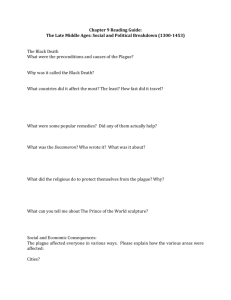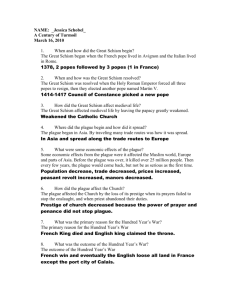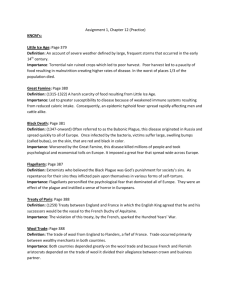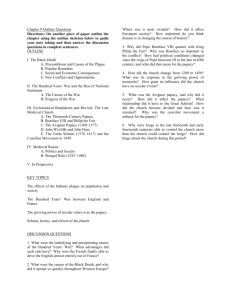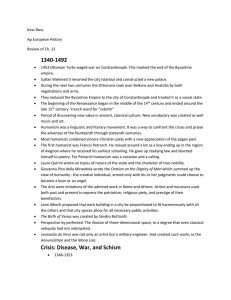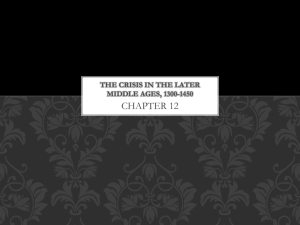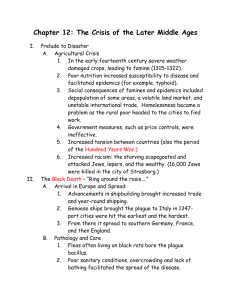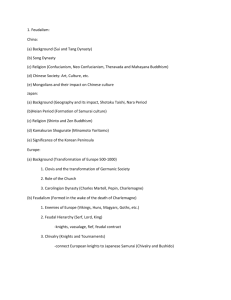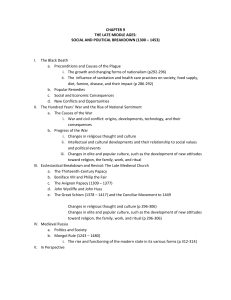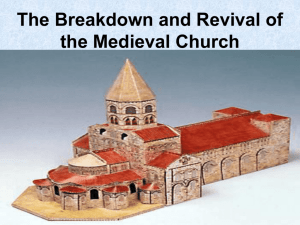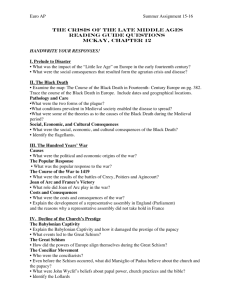The Late Middle Ages 1300-1453 - Mr. Gonzalez`s History Classes
advertisement
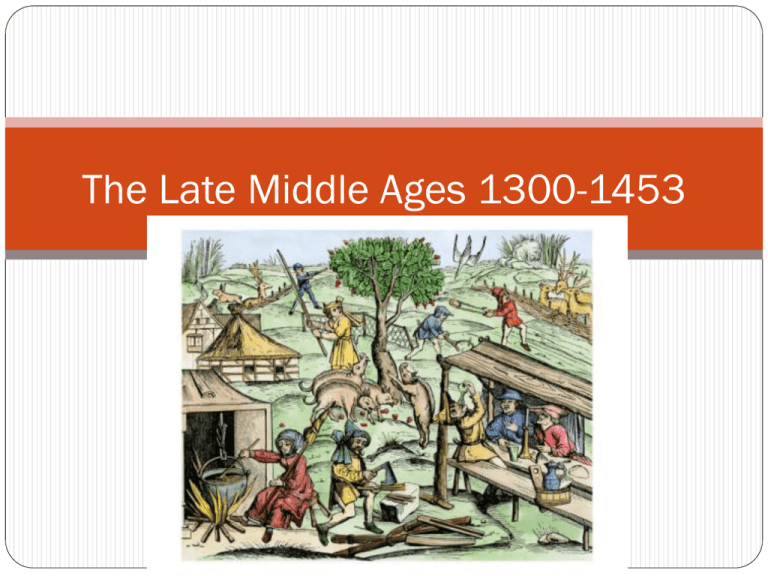
The Late Middle Ages 1300-1453 Key Terms Black Death Boccaccio and Decameron Taille Jacquiere Hundred Years War Estates General Edward III Essential Questions What were the effects of the bubonic plague on population and society? How did the Hundred Years’ War between England and France affect the different social, political, and religious institutions of Europe? What was the effect of the growing power of secular rulers over the papacy and how did schism and heresy lead to reform of the church? The Black Death Also known as the Bubonic Plague, the Black Death attacked in various waves between 1348 and 1350. 2/5 of the population in Europe were dead. Preconditions of Plague Causes of Plague Europe was dangerously Overpopulation overpopulated as the population of Europe doubled between 1000 and 1300 What are some issues that come with overpopulation? What are some of the effects of overpopulation? Famine Bad Health Economic Depression Migration of Black Death The Black Death followed the trade routes from Asia into Europe, entering into Europe through trading ports in italy beginning in 1348. What regions of Europe do you think would be most affected?What areas do you think would be least affected? Migration of Black Death Social Reactions to the Plague Little could be done about the plague due to limited knowledge about the disease. Behavior that went against the social norms of the time was prevalent in high stricken areas Flagellants sought to bring themselves divine intervention by beating themselves in ritual penance. Why could this have been a problem? Social and Economic Consequences What happens to the value of a worker if population goes down? As a result of huge population loss in Europe, wages increased for almost every occupation Noble landholders suffered a significant loss of power Why is this important? Do you think this is going to last? Noble Pushback and Peasant Revolt Landowners sought to reverse their losses by passing new laws that restricted peasant gains Wages were frozen Peasant movement was restricted Taxes, such as the taille in France, were implemented in order to give the upper class more money As a DIRECT result of these measures, peasants staged protests and uprisings throughout Europe, with the most famous uprising being known as the Jacquerie Nobel Suppression of Jacquerie Example of inhumanity going both ways Peasants"killed a knight, put him on a spit, and roasted him with his wife and children looking on. After ten or twelve of them raped the lady, they wished to force feed them the roasted flesh of their father and husband and made them then die by a miserable death. The ruling class quickly regrouped from their early losses due to their military advantages: “Like every insurrection of the century, it was smashed, as soon as the rulers recovered their nerve, by weight of steel, and the advantages of the man on horseback, and the psychological inferiority of the insurgents” Winners, Losers, and More Note:When looking at important historical events we always need to try to analyze the ways in which each social group was affected. Winners: Cities and City Populations: People living in the city were generally people who were skilled laborers (artisans merchants etc..) Why would these people have benefitted from the plague? Losers: People from the countryside: less of a population meant that there were less crops being consumed, driving prices and profits DOWN Undecided: The Church: Lost revenues from their landholdings but accounted for it with increased revenue coming from the services of the dying. Review: What social group suffered the greatest decline in power as a result of the plague? A. Noble Landholders B. Urban Elites C. Clergy D. Artisans E. Peasants Review As a result of the Black Death, it is estimated that the population of western Europe was reduced by ____ percent A. 40 B. 50 C. 60 D. 70 E. 80 Review All of the following contributed to the outbreak of the Hundred Years’ War EXCEPT A. The proximity of England and France B. Edward of Englands control of French Territories C. Religious differences D. A quarrel over Flanders E. A history of prejudice and animosity between the two peoples Recall: Who did people pledge their allegiance to before the Hundred Years War? How did this change during and after the war? The Hundred Years War and the Rise of National Sentiment Main Ideas The 100 Years War called for a series of alliances between kings and nobles that led to the lower peasant class shouldering the burden for a very costly war Joan of Arc gave the French a sense of national identity which brought with it a rise in nationalism in both France and England Englishmen became Englishmen and Frenchmen became Frenchmen Breakdown of the Medieval Church and Revival Issues within the Church Pope Innocent III’s power grab by extending the plentitude of power doctrine led to a more centralized church, making it very similar to a papal monarchy Made the church stronger politically but weaker spiritually Why? This pattern of increased centralization continued throughout the rest of the century and would continue to be a problem, eventually leading to the Reformation (REMEMBER THIS!!) Fragmentation within the church would continue to be an issue Conflict with State Governments Increased centralization of the church and its increased power came at a time when state governments were also becoming more centralized and powerful The church and state governments became entangled in conflict over the authority that the state had over its people, including clergy The Church quickly realized that it was no match for the increasing power of national states. The Avignon Papacy aka the Babylonian Captivity and Movement Toward Schism In the early 14th century, Pope Clement V moved the papacy from Rome to Avignon. Why is this significant? Why was this done? Why could this be a problem for the Church? The church fell under the influence of the French crown, further steering it away from spirituality. The distance away from Rome also impacted their finances, as they were unable to collect funds from Roman Estates What happens as a result of this? Consequences of the Avignon Papacy The need for new sources of income Indulgences Pardons for unrepented sins that could be purchased for the living or dead to limit the amount of time in purgatory. Why could this be a questionable decision? Continued conflict with state governments led to states asserting more dominance over their land How would they do this? Marsilius of Padua wrote in his Defender of Peace that spiritual laws proclaimed by the church had no place in the secular world unless a secular ruler deemed it a secular law John Wycliffe and John Hus Could be described as very early protestants (that will make more sense in a couple of weeks) Argued that the Catholic Church was living in excess and that the sale of indulgences was immoral and that the pope was not perfect Why does this matter? Their followers were called Lollards and Hussites The Great Schism (1378-1417) and the Conciliar Movement to 1449 Pope Gregory XI returned the papacy to Rome in 1377 but died a year later. (WOMP) Upon dying two competing groups of cardinals (not the baseball team) elected two different popes to serve. One was chosen to return to Avignon, the other to Rome. Eventually a third pope (Alexander V) was elected to be pope Why would this be a problem? The Great Schism would have a lasting legacy on the Catholic Church for hundreds of years Conciliar Movement A movement within the church that sought to keep the power of the pope in check by allowing a council to look out for the church as a whole. Secured initial success by ending the Great Schism but did not last for long, as the pope eventually secured his authority over the church within the following decades. Legacy of the Middle Ages The end of the middle ages saw Europe undergo a major change in the fabric of everyday life. Social, religious, and economic upheaval saw the lives of people around Europe transform, leaving a long lasting legacy that would be felt during the Renaissance and into the Reformation and beyond. Most importantly, the end of the Middle Ages saw the beginning of the rise of individualism and with it, an enduring battle between individualism and community that would be felt for centuries to come.

